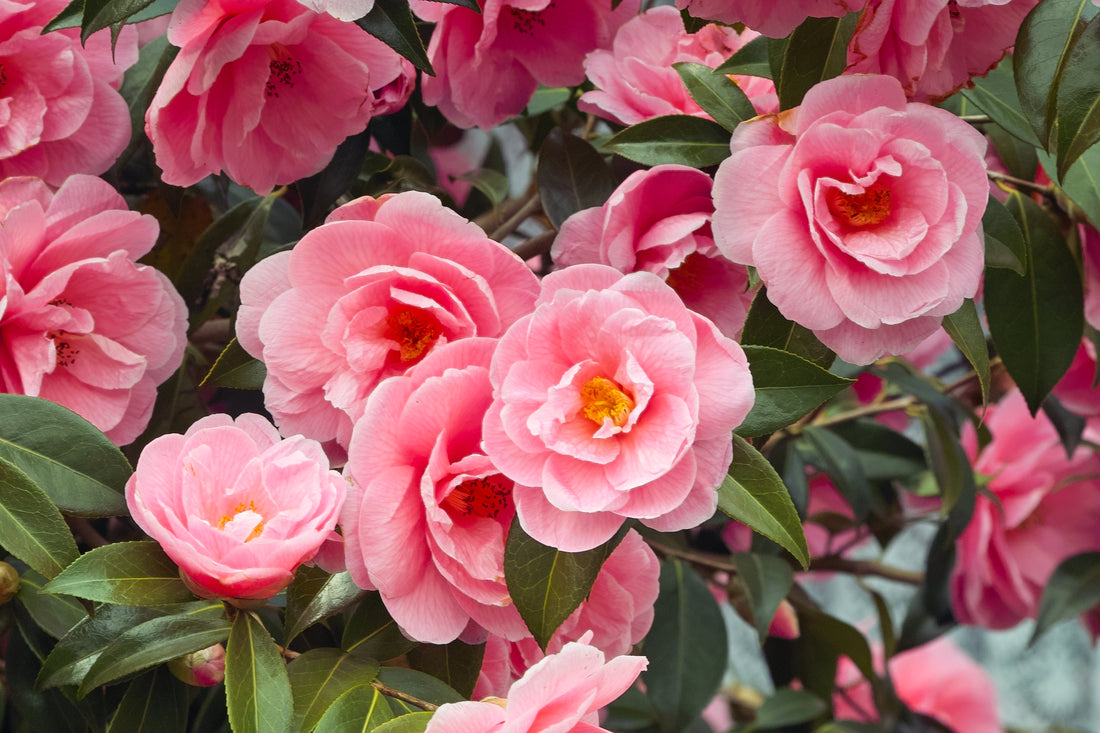
How to Tissue Culture Camellia?


About Camellia
Camellias are one of the most popular woody ornamental plants. They are also known as queens of the winter flowers. They are attractive, evergreen shrubs that are extensively grown for their beautiful flowers and magnificent evergreen foliage.
Camellia is a genus of flowering plants belonging to the family of Theaceae. They consist of a range of 100-300 tropical and sub-tropical species, mainly belonging to the regions of eastern and southern Asia, from the Himalayas east to Japan and Indonesia.
Camellias grow to the height of 20 meters tall and have leaves that are alternately arranged, simple, thick, serrated, and glossy. Their flowers are large and conspicuous with five to nine petals in their naturally occurring species. They generally appear in late winters but some varieties bloom in late fall or mid-spring.
These plants have several economical uses such as leaves C. sinensis are popular teas used in the regions of East Asia, Southeast Asia, and the Indian subcontinents; C. japonica, C. sasanqua, and their hybrids are ornamental plants that are used as garden cultivars; and C. oleifera produces tea seed oil that is used in cooking and cosmetics.
About caring for the plants, they prefer moist, well-drained soil, having 6.5 pH; they need to be regularly watered for a couple of years to keep them wet, but don’t overflow them, and often pruning is needed to remove crossover limbs or diseased/deadwood.
Tissue Culture of Camellia
The conventional techniques to grow Camellia are cutting, grafting, or using seeds. But, these techniques are laborious and inefficient for use on a commercial scale. And, tissue culture is the best alternative. Based on the purpose the in vitro propagation of plants is categorized into two groups:
- By using shoot apices, shoot tips, and axillary buds as the explants that are useful for rapid clonal propagation, production of virus-free plants, and preservation of genetic resources.
- By using adventitious embryos or buds formed in callus culture or directly from somatic tissues that have applications in rapid mass propagation or in breeding programs where zygotic embryos, obtained from incompatible crosses, are cultured.
The procedure of Tissue Culture
Here’s a procedure of tissue culturing C. sasanqua using nodal explants, that’s taken from the Torres K.C. (1989) Micropropagation of Camellia. In: Tissue Culture Techniques for Horticultural Crops. Springer, Boston, MA. https://doi.org/10.1007/978-1-4615-9756-8_10.
Materials Required
2000-ml beaker and 250-ml beaker, sterile plastic or glass Petri dishes, bunsen burner, forceps, scalpels, culture tubes, 20% Clorox solution, Tween-20, sterile distilled water, 95% ethanol, IBA solution, MS media, sugar, agar, thiamine, Myo-inositol, BA, NAA, GA3, peat, and vermiculite.
Establishment of shoots
- Prepare shoot initiation medium containing thiamine (1.0 mg/liter), Myo-inositol (100.0 mg/liter), and BA (1.0 mg/liter).
- Dispense media in culture tubes and sterilize at 121 degrees Celsius for 15 minutes.
- Collect nodal explants from disease-free plants and sterilize for 1 min in 95% ethanol and then for 10 min in 20% Clorox solution.
- After this, rinse explants three times using sterile distilled water.
- Inoculate each explant in the culture tubes for 3 weeks at 25°C in total darkness. After 3 weeks, move the cultures to low-light conditions at 25°C for the remainder of the 12-week establishment period.
Shoot Multiplication
- Prepare the shoot multiplication medium supplemented with thiamine (1.0 mg/liter), Myo-inositol (100.0 mg/liter), BA (2.0 mg/liter), NAA (0.1 mg/liter), and GA3 (5.0 mg/liter).
- Dispense 10 ml/tube media into culture tubes and sterilize.
- Collect the established shoots, 10 mm in length, and transfer one explant to each tube. Then, incubate the cultures at 25°C under low-light conditions.
- After 8 weeks, transfer the explants to a fresh media-containing tube.
Rooting of the regenerated shoots
- Prepare a root medium containing thiamine (1.0 mg/liter) and myo-inositol (100.0 mg/liter) and adjust the pH to 5.0.
- Dispense media 10ml into each culture tube and sterilize.
- Prepare 100 ml of an 0.5 g/liter IBA solution and filter-sterilize it.
- Collect the shoots from the multiplication step, in 20 mm or more in length, and soak the 7.5 mm of micro-cutting in the IBA solution for 30 minutes.
- Transfer the micro-cutting to each culture tube and incubate them at 20°C under low-light conditions for 8 weeks.
- After a root mass is formed on a cutting, place the culture under high-lightening conditions in growth conditions, with tube closure removed, for hardening.
- After 2 weeks in the hardening environment, transfer cuttings to 5-cm2 peat pots containing the soil mixture with 3 parts bark, 1 part peat, and 1 part vermiculite by volume and place pots under intermittent mist.
Excel in Your Tissue Culture Processes with Plant Cell Technology
If you’re a beginner or a commercial scale company, plant cell technology is helping all sizes of culturists around the world. It provides world-class tissue culture equipment and tools. Its store contains MS media, agar, PPM (plant preservative mixture), plant growth hormones, gellan gum, and culture vessels.
Plant cell technology also provides unique consultation services to cannabis culturists and others to help with their processes. Using our consultation service, you can get instant solutions for your tissue culture problem by talking with our scientists!
Visit www.plantcelltechnology.com now to learn more about its offerings and programs!
Happy Culturing!!

Source: Giphy
References
- Torres K.C. (1989) Micropropagation of Camellia. In: Tissue Culture Techniques for Horticultural Crops. Springer, Boston, MA. https://doi.org/10.1007/978-1-4615-9756-8_10.
- https://www.jircas.go.jp/sites/default/files/publi...
- https://en.wikipedia.org/wiki/Camellia
- https://www.gardendesign.com/flowers/camellias.htm...
Blog Categories
View by Level
Popular Blogs

6 Plant Tissue Culture Books to Keep Learning
Introduction Most of us are fans of books when it comes to learning a topic in detail and in a...
Read More
New Technical Agar Vs Supreme Agar
Introduction What’s the secret element that supports and holds plants in vitro? Not sure? It’s the solidifying agent. Solidifying agents...
Read MoreSubscribe to Our Newsletter







Join the conversation
Your email address will not be published. Required fields are marked